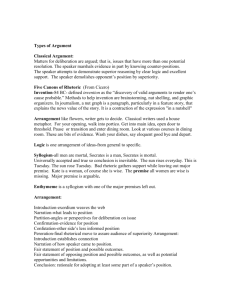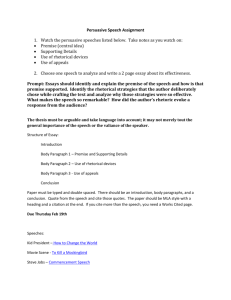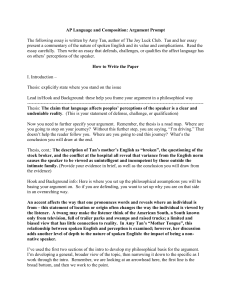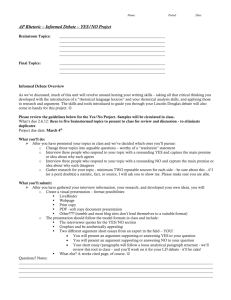ETHICS AND SOCIAL ISSUES
advertisement
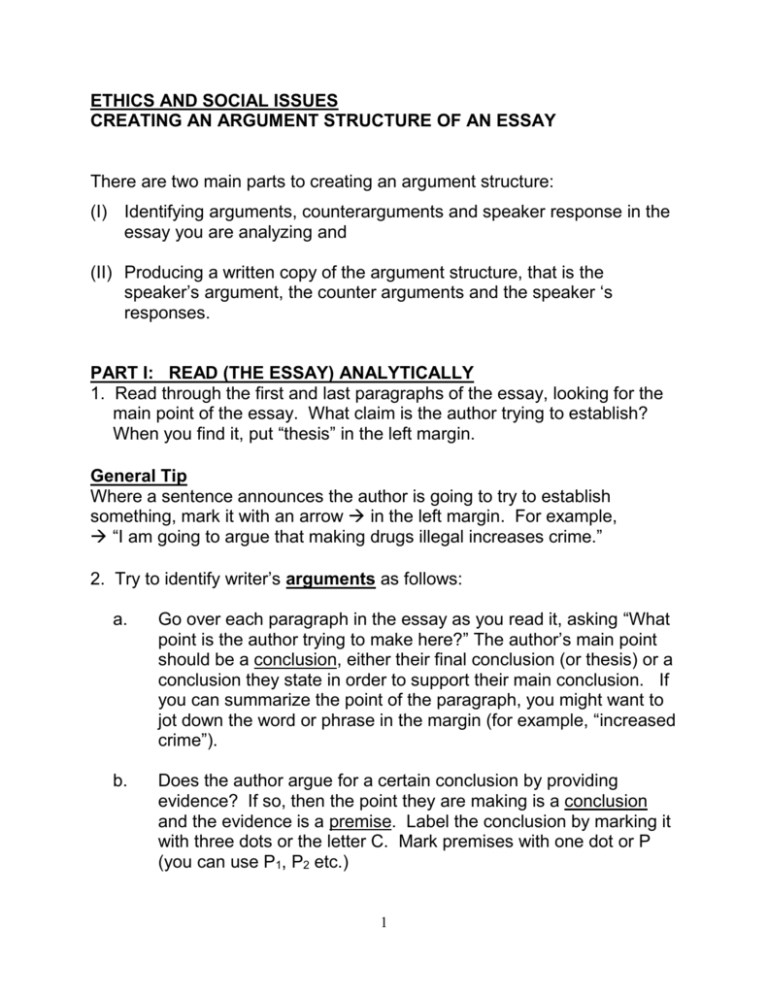
ETHICS AND SOCIAL ISSUES
CREATING AN ARGUMENT STRUCTURE OF AN ESSAY
There are two main parts to creating an argument structure:
(I) Identifying arguments, counterarguments and speaker response in the
essay you are analyzing and
(II) Producing a written copy of the argument structure, that is the
speaker’s argument, the counter arguments and the speaker ‘s
responses.
PART I: READ (THE ESSAY) ANALYTICALLY
1. Read through the first and last paragraphs of the essay, looking for the
main point of the essay. What claim is the author trying to establish?
When you find it, put “thesis” in the left margin.
General Tip
Where a sentence announces the author is going to try to establish
something, mark it with an arrow in the left margin. For example,
“I am going to argue that making drugs illegal increases crime.”
2. Try to identify writer’s arguments as follows:
a.
Go over each paragraph in the essay as you read it, asking “What
point is the author trying to make here?” The author’s main point
should be a conclusion, either their final conclusion (or thesis) or a
conclusion they state in order to support their main conclusion. If
you can summarize the point of the paragraph, you might want to
jot down the word or phrase in the margin (for example, “increased
crime”).
b.
Does the author argue for a certain conclusion by providing
evidence? If so, then the point they are making is a conclusion
and the evidence is a premise. Label the conclusion by marking it
with three dots or the letter C. Mark premises with one dot or P
(you can use P1, P2 etc.)
1
c.
Identify the speaker’s value judgments and label them ‘VJ’ (they
might not be stated).
d.
Make dividing lines where an argument appears to end.
e.
If you can, give each argument a name. For example, you might
want to name one argument “Argument from Increased Crime.”
3. Identify counter arguments to the speaker’s position as follows:
a.
Look for where the author argues against their own point of view
or presents someone else’s objection to their point of view.
b.
Label the counterargument “Counterargument” or “Objection.”
c.
Follow steps c. – e. in step 2 above.
4. Identify the speaker’s response to objections as follows:
a.
Look for where the author responds to an objection or
counterargument they have stated.
b.
Label the speaker’s response “Counter-Objection.”
c.
Follow steps c. – e. in step 2 above.
PART II: REPRESENTING THE ARGUMENT STRUCTURE OF ESSAY
The second step is to write the speaker’s arguments, the objections
to their arguments (or the counterarguments) and the speaker’s response
to the counterarguments, with the appropriate headings.
I) REPRESENTING THE SPEAKER’S ARGUMENT
1.
Make a heading “SPEAKER’S ARGUMENT.”
2.
Conclusion: Type and label the speaker’s conclusion. Sometimes
one argument will have more than one conclusion and you need to
2
show both. In an argumentative essay the conclusion should be a
type of value statement.
3.
Premises: To show the sentences that support a conclusion (i.e. the
premises) type them under (or above) the conclusion they support,
indenting them ½ inch from the left margin (the conclusion should be
lined up at the left). For example, in the following example about John
becoming a veterinarian, the premise about John getting along with all
sorts of animals {Premise 2} is indented from the left underneath the
conclusion, John should be a veterinarian. Identify any value
judgments as value judgments. If you want, label the premise by topic
(for example, ‘good with animals’ might be a premise label).
4.
Premises Supporting Other Premises (Nested arguments):
Sometimes one premise supports (tries to prove) another. For
example, in the argument below there is a premise about a wild boar
{P2a} that supports the premise about John getting along with animals
{P2}. To show that the premise about the wild boar supports Premise
2, place the sentence about the wild boar under Premise 2, label it
P2a, and indent it another ½ inch so that you have one indentation
within another:
Conclusion
Premise (supporting the conclusion above)
Premise (supporting the premise above)
5. Value Judgments: In arguing for their thesis (or proposal) the author
needs to use some value judgment as a premise. For example, to
support the conclusion “We should prevent people from buying
machine guns” the author might use the premise “We should protect
others from harm.” If the author states their value judgment, indent it
(as you would any premise) and identify it as a value judgment. If the
author doesn’t explicitly mention a value judgment, but you can figure
out what it would need to be, write it in as an “unstated premise.”
II) REPRESENTING COUNTERARGUMENT STRUCTURE
3
1.
Make a heading “COUNTER ARGUMENT.”
2.
Identify and represent the counterargument just as you did in Steps 2-5
above.
III) REPRESENTING SPEAKER’S RESPONSE
1.
Make a heading “SPEAKER’S RESPONSE.”
2.
Identify and represent the speaker’s response to the counterargument,
just as you did in Steps 2-5 above.
EXAMPLE:
Original Essay
I really think that John should be a veterinarian. After all, veterinarians are
animal doctors and we all know that John gets along with all kinds of
animals. Remember that camping trip on Santa Cruz Island last summer?
When a wild boar visited our campground John was able to stop it from
raiding our food and coax it away from the campground. And his sister told
me that John has always taken care of the animals on his father’s farm. I’m
not sure what qualities are important for being a veterinarian, but I know
that John is meticulous and he likes to help animals. On the other hand,
John’s grades aren’t very good. He also doesn’t have enough money to
pay for veterinarian school and he has a family to support. But there are
good student loans available. Maybe John should apply to veterinarian
school, take out a student loan, and move into his brother’s house for a
couple of years.
4
ARGUMENT STRUCTURE
Speaker’s Argument
{Conclusion 1} John should be a veterinarian.
{P1, Definition}: Veternarians are animal doctors.
{P2}: John gets along with all kinds of animals.
{Premise 2a}: When a wild boar visited our campground John
was able to stop it from raiding our food and coax it away from
the campground
{Premise 2b}: John has always taken care of the animals on
his father’s farm.
{P3}: John is meticulous.
{P4}: John likes to help animals.
{P5 – unstated}: Value Judgment: You should work at what you like
doing. (This can go in any order within the premises.)
Counterargument to Speaker (Objection)
{counterargument to conclusion 1}: John shouldn’t be a veterinarian.
{P1} John’s grades aren’t very good.
{P2}: John doesn’t have enough money to pay for veterinarian school.
{P3}: John has a family to support.
{P4 – unstated}: Value Judgment: You should support your family
Speaker’s Response to the Counterargument (counter-objection)
{Conclusion 2}: John should apply to veterinarian school, take out a student
loan, and move into his brother’s house for a couple of years.
{P1} There are good student loans available.
5
6

